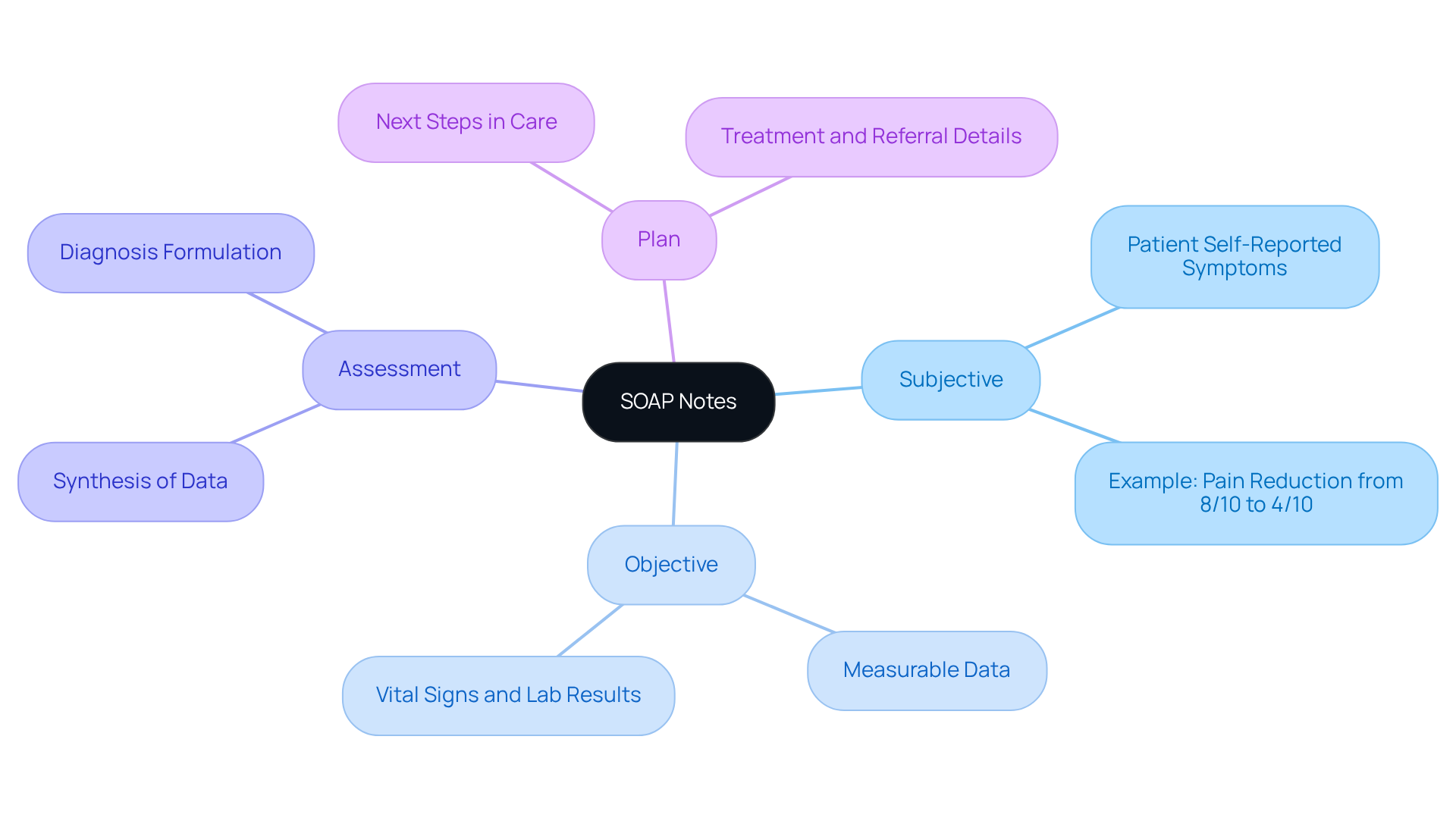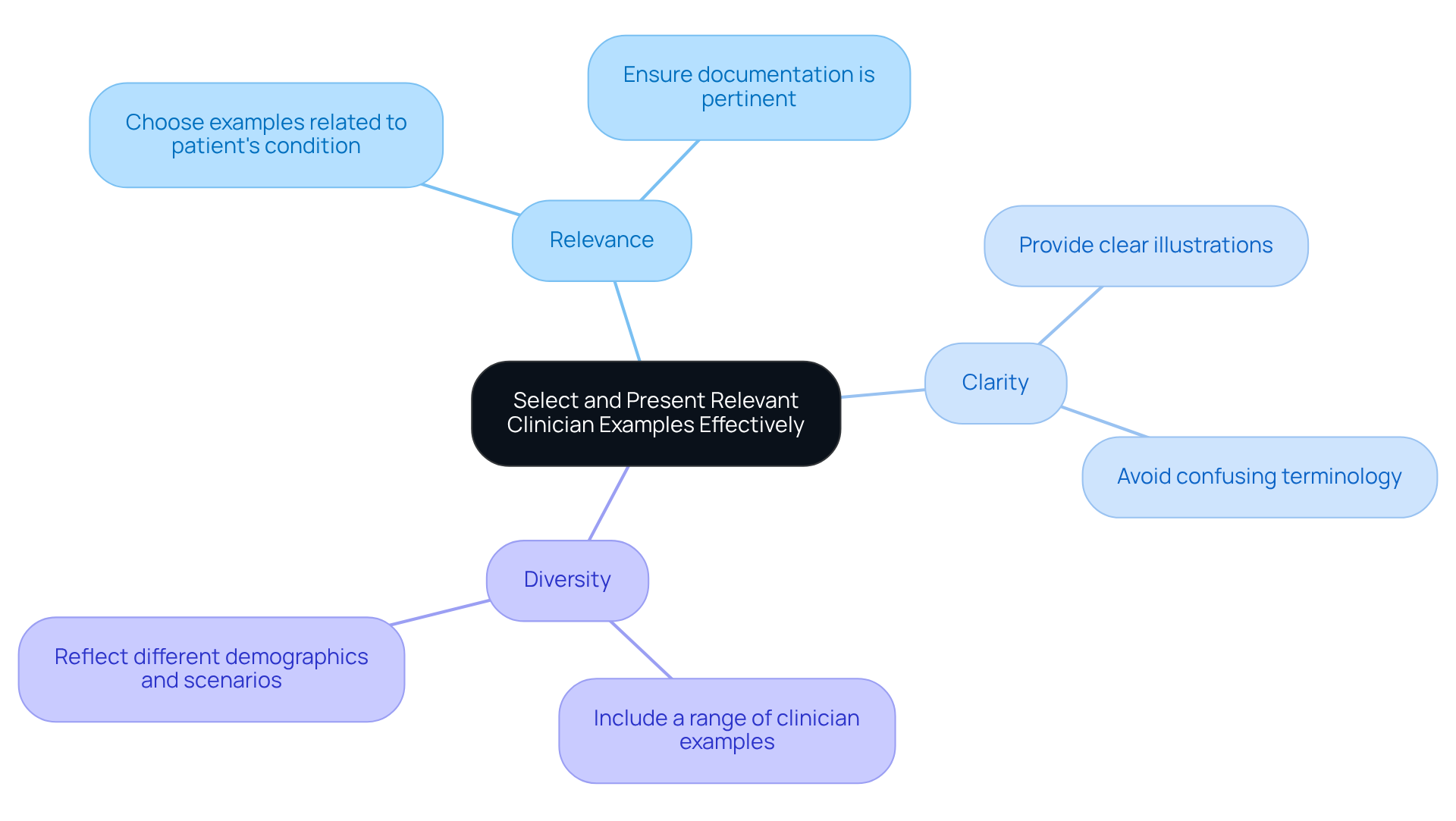Overview
In the demanding world of healthcare, providers often face emotional challenges that can impact their ability to deliver the best care. The article highlights four key practices for effectively using clinician examples in SOAP notes, emphasizing their vital role in enhancing documentation clarity, patient engagement, and overall care outcomes. By incorporating relevant, clear, and diverse clinician examples, healthcare providers can foster a culture of feedback and adaptation. This approach not only improves communication but also ensures that care is tailored to individual patient needs. Ultimately, this leads to better health outcomes, nurturing a more compassionate healthcare environment.
How can you incorporate these practices to enhance your documentation and patient interactions?
Introduction
In the intricate world of healthcare, effective communication can often be the difference between a successful patient outcome and a missed opportunity. SOAP notes—structured documentation encompassing Subjective, Objective, Assessment, and Plan—are essential tools that not only streamline this communication but also enhance patient care. Yet, how often do healthcare professionals feel overwhelmed by the demands of documentation?
Administrative burdens can weigh heavily on providers, impacting their ability to connect with patients. By integrating clinician examples, providers can transform their SOAP notes into powerful narratives. These narratives not only inform but also resonate with both colleagues and patients, fostering a deeper understanding of treatment strategies.
Imagine the impact of clear, engaging documentation on health outcomes. It’s not just about recording information; it’s about creating a shared understanding that empowers patients and enriches their care experience. Let’s explore how elevating documentation practices can lead to more meaningful interactions and ultimately improve patient outcomes.
Understand the Structure and Purpose of SOAP Notes
SOAP notes—an acronym for Subjective, Objective, Assessment, and Plan—are more than just a documentation format; they are a lifeline in healthcare communication, fostering continuity of care. Have you ever felt overwhelmed by the complexities of patient documentation? Each component of SOAP notes, such as clinician examples, plays a vital role in alleviating that burden.
- Subjective: This section captures the patient's self-reported symptoms and feelings, providing invaluable insights into their experience. For example, when a patient reports a reduction in pain from 8/10 to 4/10 after treatment, it highlights their progress and informs care decisions.
- Objective: Here, clinicians document measurable data, including vital signs, physical examination findings, and lab results. Clinician examples illustrate how this objective information is crucial for evaluating the individual's condition and guiding treatment choices.
- Assessment: This component synthesizes subjective and objective data to formulate a diagnosis or clinical impression. It empowers healthcare providers, such as clinician examples, to assess the effectiveness of the treatment plan and make necessary adjustments, ensuring that care is responsive and tailored to the patient’s needs.
- Plan: The plan outlines the next steps in care, detailing treatments, referrals, and follow-up appointments. A well-structured plan with clinician examples ensures that all providers involved in the individual's care are aligned and informed, promoting a seamless care experience.
By employing this organized method, healthcare providers not only enhance documentation efficiency but also foster better communication among themselves, ultimately resulting in improved outcomes for individuals. Have you considered how precise and effective SOAP notes can influence your practice's financial well-being? They enable and minimize the risk of denied claims, allowing you to focus on what truly matters: your patients.
As the healthcare landscape continues to evolve, the significance of SOAP notes in sustaining high-quality care remains paramount. Embrace this structured approach and witness how it can transform your practice and enhance the care you provide.

Incorporate Clinician Examples to Enhance Documentation
Incorporating clinician examples into documentation can significantly enhance the clarity and relevance of SOAP notes. Imagine a healthcare professional crafting a treatment strategy for an individual, referencing a specific instance where a similar method yielded positive outcomes. This not only serves as a reference point but also illustrates the healthcare professional's thought process, fostering transparency in care decisions.
Utilizing examples can aid in several key areas:
- Clarifying Complex Cases: Have you ever encountered multifaceted patient issues? Clinician examples can illuminate the decision-making process, thereby making it easier for both clinicians and patients to understand the rationale behind treatment choices. Educating peers by sharing clinician examples becomes a valuable learning tool for less experienced clinicians, promoting best practices and enhancing team knowledge. Enhancing understanding of individuals is facilitated by clinician examples, as individuals are more likely to comprehend their own treatment alternatives and the reasons behind them when presented with instances of comparable cases. This approach aligns with findings indicating that engagement strategies can lead to a 23% improvement in financial outcomes and a 21% enhancement in clinical outcomes.
- Enhancing Client Engagement: Involving individuals through relatable examples fosters a deeper connection to their care, ultimately leading to improved adherence to treatment plans. Studies show that organizations with developed client engagement capabilities achieve 41% improved long-term research results, underscoring the importance of effective communication in healthcare.
Furthermore, the increasing focus on individual involvement is underscored by the £2.8 billion worldwide investment in engagement capabilities in 2023. This investment reflects the growing recognition of the value of patient-centered approaches in healthcare.
By incorporating clinician examples into SOAP notes, providers can not only enhance the quality of records but also boost individual comprehension and involvement, ultimately leading to improved health outcomes. Let’s embrace these practices, fostering a supportive environment that prioritizes patient engagement and understanding.

Select and Present Relevant Clinician Examples Effectively
When selecting clinician examples for documentation, it’s important to consider strategies that resonate with the emotional and practical challenges faced by healthcare providers:
- Relevance: Choose examples that closely relate to the patient's condition or treatment plan. This ensures that the documentation is pertinent and truly useful.
- Clarity: Provide illustrations in a clear manner, steering clear of terminology that might confuse other healthcare professionals or the individual receiving care.
- Diversity: Include a range of clinician examples that reflect different demographics and clinical scenarios. This approach helps in addressing the needs of a varied population, fostering inclusivity.
For instance, when recording a treatment strategy for a diabetic individual, a healthcare professional might refer to a successful case of another diabetic person who enhanced their condition through lifestyle modifications. This not only offers a model for the current patient but also strengthens the healthcare professional's expertise, showcasing the power of shared experiences.
By embracing these strategies, we can enhance our documentation practices, ultimately leading to better patient care and outcomes.

Continuously Improve Practices with Feedback and Adaptation
To foster continuous improvement in documentation practices, clinicians are encouraged to embrace a nurturing approach that acknowledges their challenges:
- Seek Feedback: Regularly solicit input from colleagues and supervisors regarding the clarity and effectiveness of documentation. How often do we take a moment to ask for constructive criticism? Structured peer reviews or informal discussions can create an environment where feedback is valued. CosmaNeura emphasizes the importance of cooperative development, enhancing the feedback process and leading to superior record-keeping practices.
- Reflect on Care Outcomes: Consider how record-keeping influences client care results. Have you noticed the connections between particular documentation methods and improved patient satisfaction? Recognizing these relationships can empower healthcare providers to strengthen effective strategies. For instance, by adopting better record-keeping methods, providers can reclaim valuable hours each day that were once spent on administrative tasks, aligning with CosmaNeura's mission to alleviate burdens on doctors and enhance care quality.
- Adapt Practices: Embrace the idea of adapting record-keeping strategies based on feedback and observed outcomes. Are you open to integrating new technologies, such as AI-driven record-keeping tools from CosmaNeura? Updating existing templates can also help align with the evolving needs of individuals and providers.
By fostering a culture of feedback and adaptation, clinician examples can significantly enhance the quality of documentation, ultimately leading to and better clinical outcomes. Case studies showcasing CosmaNeura's impact on healthcare delivery illustrate the practical benefits of implementing effective feedback mechanisms. Let's take these steps together, nurturing a more supportive and efficient healthcare environment.
Conclusion
Utilizing clinician examples effectively within SOAP notes is crucial for enhancing healthcare documentation and improving patient outcomes. By adopting a structured approach that emphasizes the importance of each component—Subjective, Objective, Assessment, and Plan—healthcare providers can streamline communication and ensure that care is tailored to individual needs. Have you ever considered how the integration of clinician examples not only clarifies complex cases but also fosters patient engagement? This ultimately leads to better adherence to treatment plans.
Key insights from the article highlight the significance of selecting relevant and diverse clinician examples that resonate with patients' experiences. By seeking feedback and adapting practices, we can cultivate a culture of continuous improvement in documentation. This approach not only enhances the quality of records but also empowers healthcare professionals to refine their methods based on real-world outcomes.
In conclusion, embracing these best practices for using clinician examples is vital for fostering a patient-centered approach in healthcare. By prioritizing effective documentation and leveraging the power of shared experiences, healthcare providers can enhance communication, improve patient engagement, and ultimately deliver higher quality care. The journey towards better documentation and patient outcomes begins with a commitment to these practices—let's take the necessary steps to transform healthcare together.




